 |
||
|
||
| ||
Some naive users consider that manufacturers make new products in order to solve users' problems. The most cynical people are sure that companies do not care about end-users at all and that they are interested only in money. The truth is as always somewhere in the middle. Obviously, any commercial firm is interested in incomes. The main advertizing law contradicts to the banal truism and states that Offer produces Demand. There is no demand for something absolutely new just because no one knows why to use it. First it's necessary to think something out, then explain to users what they can get, and they will go for a buy though they didn't realize before they had such problems ;)). But reality is not that simple. It's just not necessary to solve user's problems directly; it's enough to develop something which would solve problems the users' demands can be brought to ;) A bright example is storage of photos when a PC is not at hand. A direct solution can be an increase of the flash memory size together with considerable pricecuts, but it's still to tough for the current industry. Many photographers have bought notebooks and subnotebooks so that they can easily transfer shots from the memory cards to their hard drives. But a notebook itself is not needed. What they need is a hard drive, batteries and a memory slot. What did the manufacturers do? They developed a device called photo hard drive. Was that a direct solution of the problem? No, it wasn't, especially because users themselves have found similar ways (using notebooks). But a new market was created. The only thing left to do was to explain to users that now they could take their digital cameras for a month to the mountains, and it would be cheaper and more portable than a notebook. Thus the process started. Why not to expand the market if it turns out to be profitable? Photos can be recorded not only on a hard drive, but directly on CDs in the field conditions. It will take no time for you to transfer them to your PC since you won't have to make time-taking connections. Also, you can take such CDs to photo labs to print out the shots. And not every lab would receive a photo hard drive. Another good example is when you take shots of some event. You can quickly make as many copies of the shots as needed and give CDs to all participants on the spot. Such solution has a lot of advantages; the PR agencies have a lot more examples ;). It's important that it's not a problem to make such device at the current stage of development. It won't be difficult to sell them either. So, the today's hero, Apacer Disc Steno CP100, is an external combo CD-RW USB 2.0 drive with a self-contained power supply and a multiformat card reader. As expected, functions of a combo driver are better than those of a sum of features of its components: the drive can be used for direct recording from memory cards to CDs in field conditions without using any additional equipment. Drive as it isThe weight and dimensions are not small: 184 x 187 x 33 mm at almost 700 g (693 g with a battery, 597 without it). Well, even the most compact CD-RW drive is much bigger than a 2.5" hard drive, plus other components. An idea of using 80mm CDs doesn't look that attractive because these discs are not very capacious. Let's wait for at least 80mm DVD :) I didn't take shots of all its sides because there is a good flash clip that carefully shows all its parts.  Simple but elegant. 6 LEDs can inform you about almost every its aspects of operation (external power supply, batteries, activity, readiness, USB connection, errors). Fortunately, there are two buttons for recording the cards' contents onto CDs while inexpensive photo hard drives are usually deprived of the check mode at all, and it's not always possible to make 2-3 copies if a hard drive doesn't have a large size. The USB and external power supply connectors, CF and universal 4 in 1 (SMC/MMC/SD/MS) slots are placed on the drive's sides, and the CD is on top. The drive incorporates a compact notebook-type CD-RW from Matsushita with the speeds of 24/10/24. It doesn't break records, but in general it looks good (my Plextor drive has 12/10/32 and I'm not going to replace it ever). It's nice that the drive supports high-speed CD-RW, especially because this is what it's meant for. The other specs are a match for the speeds: they are not on the industrial cutting edge, but they are average features without luxurious names but suitable for most users. The accessory pack is not that bad: a USB cable, a power supply unit, a transportation bag, CDs with drivers, user guide and Nero Burning Rom, a couple of black CDs, a printed manual and a rechargeable battery. The latter looks very interesting. Have a look:
They look unusual, but you can easily find them in the stores at a low price. One unit is not very capacious, especially because this CD-RW drive is not a low-power-consuming device. The manufacturer guarantees only 16 cards of 64 MB but its comparable to photo hard drives which nonetheless demonstrate much better scores. More precise tests are too expensive because they depend on use conditions (Li-Ion is very sensitive even to the air temperature), but I think that in case of sizable cards you can record at least 3 discs. Isn't not much, and an extra battery would be handy. Operation when not connected to PCThe only function the device can do when it's not connected to PC is to transfer contents from memory cards to CDs. But this is what many want. The procedure is very easy and similar to that with analog devices based on a hard drive. You must insert the card into the respective slot, a disc into the drive (what disc types can be used will be mentioned later), press one of the big buttons, and copying will start... Unfortunately, it's not fast, the speed is approximately 1MB per second, like that of the X's-Drive of both modifications, i.e. about 2 minutes for a 128MB card. After copying we get a new folder with the files from the flash card. But actually we got a new record session. The disc then doesn't get closed, that is why you can add more files. But remember that each session makes "nonproductive expenses" of the disc space. It's better to use cards of big size and transfer shots when the card is filled up, but it's not very convenient: a CD measures 650 or 700 MB, while the card size is divisible by 2 in power. The most optimal tandem is a 640MB card and a 650MB disc because of minimal losses, simple utilization and maximum power saving. This problem could be solved with packet recording. But in this case we face another more grave problem - where to format discs? Right in the drive in field conditions? It would take a lot of time. Only at home? You may have not enough discs. Besides, the UDF is targeted for expensive CD-RWs, while most CD-ROM drives won't read an unclosed CD-R with this file system, and it can be a problem to give such discs to somebody else. That is why the current solution seems to be the best. As to the buttons, I think that one would be enough. Checking takes very little time (the program checks only some of files' attributes like in the Picture Pad). The record time increased by 10% is incomparable to the guarantee of successful recording, that is why the REC w/check button looks much more preferable than the REC Only. Card reader mode If you connect the drive to PC you will get two devices at once: a CD/RW drive and a high-speed card reader. Let's have a look at the latter one. The tests were carried out according to the same technology used for multiformat card readers. The memory cards are the same. Our today's hero will be compared to the 6 in 1 IEEE1394 (the reference drive), Apacer's internal drive (the fastest USB 2.0 device, plus the same company) and X's-Drive VP2060 (photo hard drive). CompactFlash
SmartMedia
MultiMedia Card
Secure Digital
MemoryStick
Although the manufacturer is the same, the controllers in the Disc Steno and in this card reader are different. The Disc Steno doesn't look superior. Owners of Sony cameras with MemoryStick cards and those who use SmartMedia may like it but all the rest... On the other had, I can't say that it fails the tests. CD-RW modeThe installation of the drive as a CD-R/RW drive brought no problems. In any Windows systems you must install the drivers before connecting the drive or go through the installation procedure after the connection (it may require rebooting). To handle the drive I used NeroBurning Rom ver 5.5.10.20 which successfully detects this model. 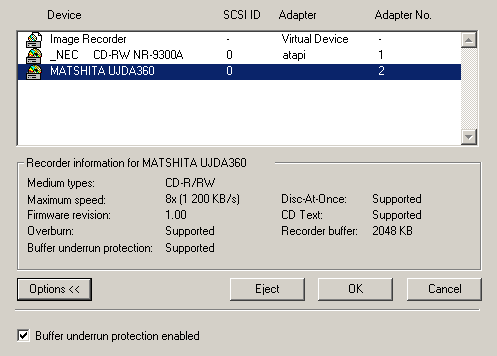 CD-R and CD-RW recordingCD recording time Traditionally, we used two types of media - with cyanine and phthalocyanine coating. The burning results will be partially represented in the graphical form.
As you can see, the drive prefers phthalocyanine media. We also checked whether the drive can burn correctly cyanine discs
at the minimal speed, - this mode is mostly used by audiophiles to get highest-quality
records.
To extend the picture, I added the burn results of the Verbatim CD-RW 10x.
Time of CD-RW full formatting in UDF with InCD ver. 3.5.2CD-RW recording in UDF format, 530 Mb test packet in 3550 files.
Operation with 80mm CDs (tested by the example of a CD-RW disc), formatting and recording in UDF Formatting and recording of the 80mm CD-RW disc in UDF. 4x write
speed.
The drive successfully reads and burns 80mm discs. BLER factor of the CD-R recorded
The most important part of the tests, and we here used the device described
in this article.
The level of errors on the SKC discs is pretty high (it seems that the drive likes them), in all other cases there are few levels. Reading of the discs recorded for the Lite-On drive with KProbe
KProbe is a new utility written for Windows OS with functions similar to the earlier used WSES; it defines the level of C1/C2 errors on a disc tested. It also depends on whether the drive "likes" a given disc. But some general information can be obtained anyway.
Overburn
The test of overburning the 90-min CD-R disc failed because the drive stopped writing it at 81:24.36. Testing main read parameters of CD discsCD WinBench 99
Judging by the test results the drive used in the Disc Steno is an average model in its class. Nero CD SpeedTest CD reading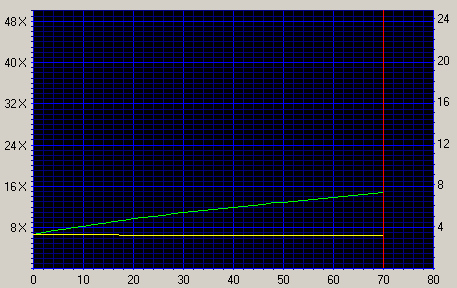
CD-ROM Drive AnalyzerCD-R reading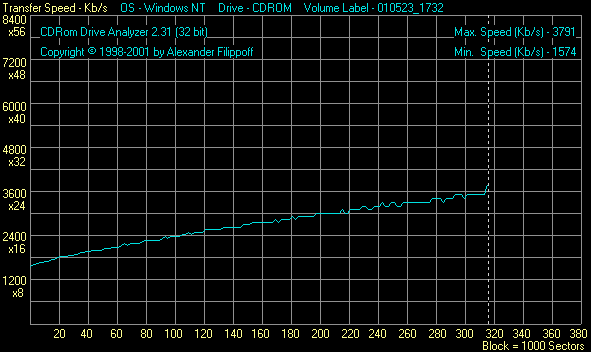 CD-RW reading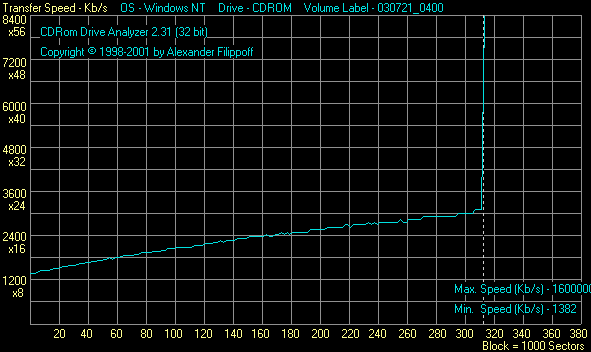 The drive couldn't detect the damaged CD, as it failed to read it. CD audio track extraction
Advanced DAE Quality (Nero CD-Speed)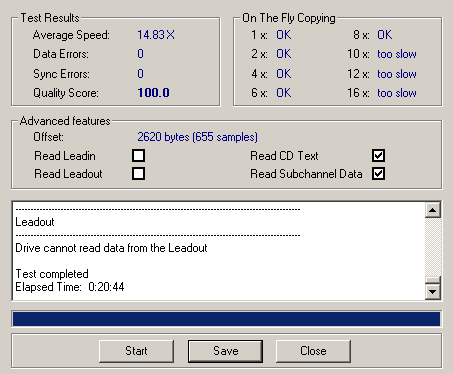 The drive reads Subchannel Data correctly. In general, it perfectly copes with this test. The detailed information on the tested parameters is given in the help file to the Nero CD Speed test program. If you don't want to download the utility, then here you can find the HTMl help file. DAE Quality (EAC) This test was made by the developer of the EAC, and it's called
DAE Quality (here you
can find its description). In short, it measures quality of audio data extraction
and quality of C2 error processing with a special test disc. In this case
it's impossible to measure the C2 processing quality, and we can show you
only the general data on audiotrack extraction quality. 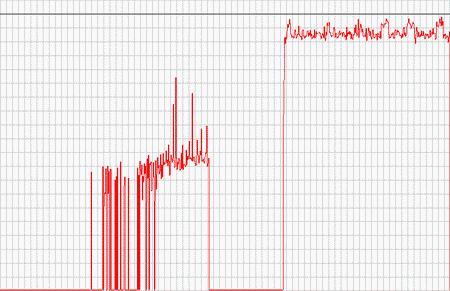
In this test the results are moderate. Direct copying of information from 780 MB CD-R (90 min.) to HDDThe drive couldn't copy the disc contents. SummaryThe drive copes quite well with its main tasks. Unfortunately, it doesn't shine as an external CD-RW drive, but the problems can solved with new firmware versions (that is why it's possible that by the moment you read this review the Disc Steno can understand 90min discs). Who might be interested in this device? I think that its dimensions and weight make it not very handy in separate utilization. Photo hard drives are more compact. On the other hand, tastes differ. The Disc Steno looks more attractive if you have a PC (portable or desktop) without a CD-RW drive. This device can be also recommended for photo studios especially in resort towns (judging by the forums, people often ask there to transfer shots from memory cards to discs). Of course, a PC makes possible to reduce the costs, but with the Disc Steno you can leave PCs for other tasks ;) So, this drive looks very interesting and useful. I won't think out spheres of applications for it because you can do it yourselves. Also it's for you to decide whether it's worth $250 (at the moment of writing this review this is the retail price on our market) or it's better to spend the money for something else and find another solution for such problems.
Andrew Kozhemyako aka Korzh
(korzh@ixbt.com)
Roman Shelepov aka SRL (srl@ixbt.com) Write a comment below. No registration needed!
|
Platform · Video · Multimedia · Mobile · Other || About us & Privacy policy · Twitter · Facebook Copyright © Byrds Research & Publishing, Ltd., 1997–2011. All rights reserved. | |||||||||||||||||||||||||||||||||||||||||||||||||||||||||||||||||||||||||||||||||||||||||||||||||||||||||||||||||||||||||||||||||||||||||||||